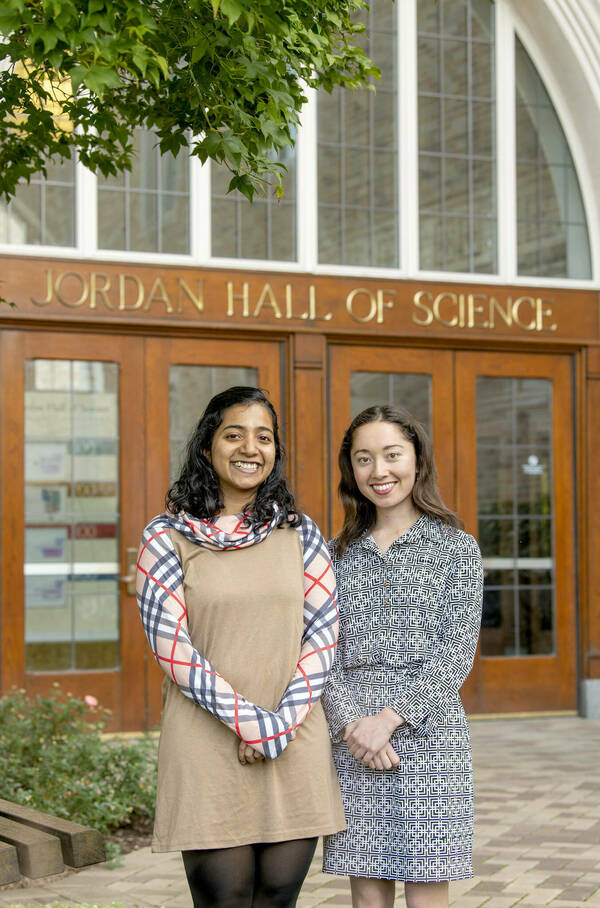

When seniors Rosie Crisman and Vaishali Nayak both heard about Scientia, the College of Science student research magazine, early in their first year at Notre Dame, neither dreamed they would someday take a leading role the publication.
While going through her old files this summer, Crisman, a science business major, found the 2016 copy of Scientia that she picked up at the Academic Exploration Fair her first week here, an initial interaction which had inspired her to join the publication’s staff. Nayak, a neuroscience major and Crisman’s co-editor, remembered reading and loving the magazine before she even arrived at college, and an announcement during her first year biology class encouraged her to work for the magazine.
Both seniors started in the news section and now oversee the entire publication process, seeking out stories, advising writers, and organizing events to promote student scientific involvement on campus.
“Science is a wonderful way to bring people together, even if they don’t have a common background,” said Crisman. “I think if it’s explained in a way that people can understand and people can get excited about, that’s the best part of science.”
In addition to news, Scientia contains full research papers by undergraduate students in biology, health, mathematics, physics, chemistry, and biochemistry. Last year, the magazine added its “Student Spotlight” section, which Nayak described as “abstracts but in magazine format.” These short pieces allow researchers who are not ready or able to publish their entire report in Scientia to still inform the Notre Dame community about their work.
According to Xuemin “Sheryl” Lu, assistant teaching professor in the Department of Biological Sciences and the publication’s faculty advisor, “Scientia provides such a unique opportunity for ND students to publish their original research, communicate with peers scientifically, and learn scientific editing and publishing. It’s built by the students and for the students. It enriches the scientific community at Notre Dame. “
Crisman and Nayak engage their own personal curiosity while promoting Notre Dame research, and their role as editors teaches them how to turn this enthusiasm into graceful leadership. Nayak learned from her predecessors how to give constructive criticism, and Crisman stressed the balance between allowing her staff the freedom to explore topics that interest them personally and expecting them to fulfill the publication’s goals. This position has helped her foster a kind persistence during her communication with Scientia’s student writers, potential lecturers, and researchers who might publish in the magazine.
“I’m really impassioned about publicizing the research of others.” Crisman said. “I firmly believe in undergrads helping and promoting the research of other undergrads.”
Just like their “Student Spotlight” section in the magazine, the publication’s “Talk Science” lecture series makes both sharing one’s own investigations and learning about other people’s research more accessible to the whole Notre Dame community. These events, which both editors cite as one of their favorite parts of their jobs, give professors and students a chance to present their findings in a casual but academic setting. Nayak and Crisman especially encourage first-year students to attend lectures, so they can explore opportunities free from stress and intimidation or even present their own research, if they have previous experience.
Nayak said “Talk Science” is exciting because, despite doing background research before inviting people to speak, she and Crisman “never really know what [the lecturers] are going to be presenting about.” They always look forward to unexpected insights from the researchers’ diverse fields of study.
As editors, Crisman and Nayak also help select undergraduates for the Charles Edison Foundation Fellowship, which provides financial support for students who would not otherwise be able to do research in addition to their academic and extracurricular commitments.
“I love reading all the applications; just seeing the passion jump out of the page and being able to really help people reach their goals,” Crisman said.
Their community-focused efforts reflect the welcoming atmosphere that brought both students to Notre Dame in the first place. A collaborative exchange of ideas also inspires their love of science itself.
“There’s always scope for discussion in science,” Nayak explained.
Nayak and Crisman returned to the Academic Exploration Fair this year, where they spread the word to a new generation of first-year students about Scientia. Crisman recalled how some students approached her and expressed an interest in working for the publication, just as she had done four years before.
”That was so incredible because I saw myself reflected in that experience too,” Crisman said.
The two seniors’ experience has come full circle, as they share their love for science with a new class of future writers, researchers, lecturers, and editors, too.
After a year of assembling the new staff, gathering student submissions, writing articles, designing the layout, and copious amounts of editing, the Scientia team will finally complete the hard copy of the publication this spring.
“I think the most fulfilling part is being able to either email out or hand people our publication evey May and say, ‘You did this. You contributed to this’” Crisman said.
If you are a student interested in publishing your research in Scientia, check out their website at https://scientia.nd.edu/ or email them at scientia@nd.edu. The editors also invite anyone curious about submitting to the journal, working on their staff, or discovering more about research opportunities in general to come to their “Talk Science” seminars.
Originally published by at science.nd.edu on October 31, 2019.